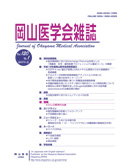

Journal of Okayama Medical Association
Published by Okayama Medical Association<Availability>
Full-text articles are available 3 years after publication.
Permalink : https://ousar.lib.okayama-u.ac.jp/16721
Fundamental Study and Clinical Evaluation of Residual Liver Function after Hepatectomy Predicted by Liver-scintigraphy
Tamai, Toyosato
Published Date
1982-04-30
Abstract
Part 1 A method of evaluating the effective liver volume has been devised for liver-scintigraphy. Matrix ROI (region of interest) was set on the anterior liver scintigram with Au-198 colloid and the depths under matrix ROI were calculated by the use of the plateau values of the histograms and the absorption coefficient (formula 2). The effective liver volume was the sum total of the areas of matrix ROI to the depths. The effective liver volume was calculated as follows: 1=∫(w)(o)Ioe(-μx)dx............(1) Io: γ-ray intensity of unit depth Ip: γ-ray intensity of w depth w: depth of radioactive substance μ: absoption coifficient therefore w=-1/μIn{1-Ip/Io(1-e(-μwo)}.............(2) Ipo: γ-ray intensity of standard depth wo: depth corresponding Ipo and the effective liver volume is V=Σ(s×wi)............(3) s: area of metrix ROI
In order to check the accuracy of this method, this was performed - the liver phantom, the dog's liver- and the patient's liver-scintigraphy. The volume obtained for the liver phantom was nearly equal to the real volume and the dog's was almost equivalent to the weight of it. The volume for every patient showed good correlation with the volume as measured by CT scan. Part 2 Liver-scintigraphy were performed in 14 preoperative patients of hepatectomy. The estimated volume of residual liver and the total effective liver volume were evaluated, and the accumulation rates of Au-198 colloid in the total liver (K) and those in the estimated residual liver (K(1)) were determined. The operation was done and 3 weeks later the same examination was performed. The following calculation was studied as the index of resectable liver volume.
(estimated volume of residual liver×K1)/(total effective volume×normal K*) *0.184 (determined in our laboratory)
The calculation values for two of 14 patients who developed liver failure after hepatic resection were 0.205 and 0.361, and for others without severe complications were more than 0.384. The results for small numbers of patients suggest that this calculation may be useful for determining the indications for hepatectomy. In regard to regeneration of the liver, only the ratio of the effective liver volume after right lobectomy (including extended right lobectomy) to it before appeared to be related to the K of preoperation.
Keywords
Liver-scintigraphy Matrix ROI
Effective Liver Volume
Predicted Residual Liver Function
ISSN
0030-1558
NCID
AN00032489
